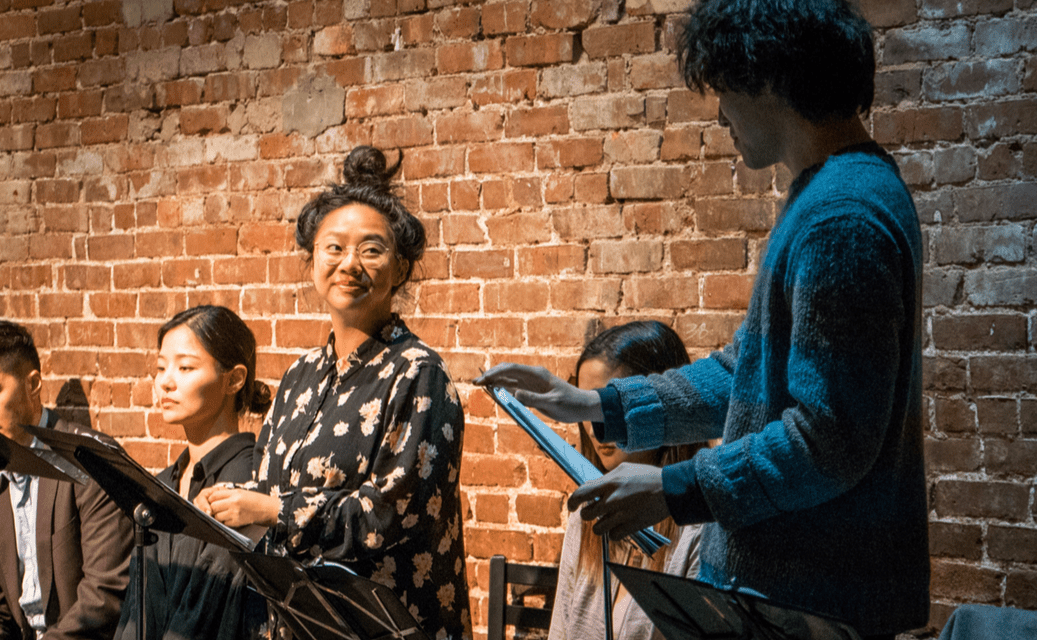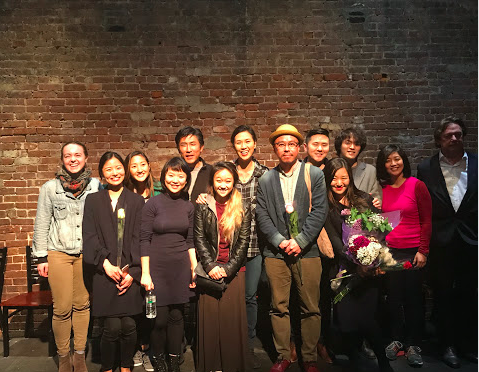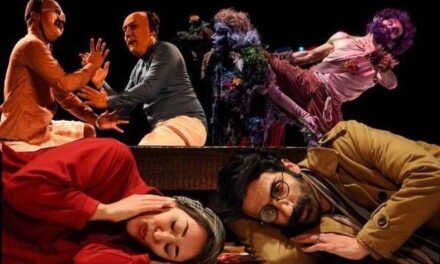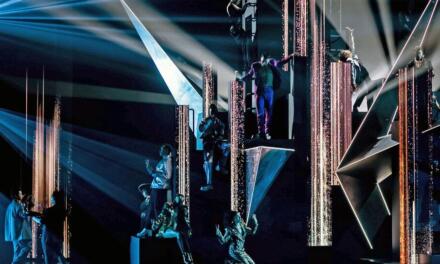Eunsung Kim is a South Korean playwright and the Director of Dalnara Dongbakkot Company. He was born in Bosung in 1977 and lives in Seoul. He received his BFA in Directing at the Korea National University of Arts. His debut play, Shidong Rahsah, was awarded with the Korea Times Award for Best Play in 2006. Kim is the recipient of multiple awards including Daesan Creative Writing Funds, Dong-A Theater Award for Best Play, Doosan Artist Award, and Cha Bumseok Play Award. His major works include Sunshine Warriors, Sister Mok-rahn, Mother Yonbian, Hamik, Uncle Soon-woo, Lunar Soap Opera, Tideland (Bbul), and Bbang Bbang Bbang. This interview was conducted after the staged reading of Kim Eunsung’s Sister Mok-rahn at the Nuyorican Poets Café as part of the PEN World Voices: International Play Festival on May 7, 2017. The playwright, director, and translator talk about their process, their response to the reading in New York, and how they feel about the cultural exchange between the theatre scenes in Korea and New Yok.
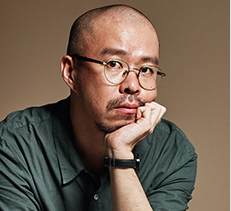
Eunsung Kim. Photo © Doosan Art Center
Interview with Eunsung Kim, the Playwright of Sister Mok-rahn (translated from Korean by Walter Byongsok Chon):
Walter Byongsok Chon: Could you talk about how you felt seeing your play in translation in New York City?
Kim Eunsung. There are two mentors who had a tremendous influence on me as a playwright. Playwrights Yoon Young-Sun and Kim Suk-Man, both veterans in the Korean theatre scene. In the early 90s, Yoon studied at SUNY Stonybrook, and Kim at NYU. I feel truly honored to follow in the footsteps of my two mentors in the same city.
Chon: What was it like listening to your words in English? How did you feel sharing your play with New York audience?
Kim: I used to think that my play told a story that was specifically Korean rather than universal. I wondered how the authentically Korean expressions could be translated into English. Thanks to Jeong Dayoung’s competent translation, I believe the story was well understood by the New York audience. I was very impressed and touched by the audience, who stayed focused and engaged through the two-hour long staged reading. One regret is that I did not get to talk in-depth with American audience members. I was hoping to get some critical perspective in addition to the praise, and wish we had more time for that.
Chon: As a Korean playwright, how did it feel to have your work translated into English and introduced in New York?
Kim: This is a rare opportunity for a Korean playwright. Like other playwrights, I hope my plays can meet more people in various places. It is a true honor that my play was staged in New York, the theatre center of the world.
Chon: What do you think this kind of an opportunity – A Korean play being translated and staged abroad – could offer Korean theatre artists and the Korean theatre scene? How do you think this kind of cultural exchange benefits the Korean artists and the theatre scene in Korea?
Kim: As I mentioned before, the majority of Korean playwrights would like to see their work meeting audiences beyond Korea. With more international opportunities for Korean playwrights, I believe Korean playwrights will be more conscious of international audiences when they portray specifically Korean stories. When playwrights ask, “How will New York audience respond to this scene?” or “How will Tokyo audience feel about this character?,” I believe plays will evolve to reflect more ubiquitous and transcendent themes and sentiments. Through international exposure, the playwrights will experience not only different theatre scenes but also different cultures and atmospheres. Such experiences, I believe, will certainly be a great asset in the playwrights’ development. International cultural exchanges will serve to cultivate more mature writers.
Chon: Do you have any message for your New York audience?
Kim: I realize it is not easy to watch a two-hour staged reading without an intermission. I was truly touched by the audience’s patience and attentiveness. I learned from mentors who studied in New York. The works of Tennessee Williams, Arthur Miller, and Sam Shephard, among others, inspired me to pursue this path as a playwright. I hope we can see each other again with another play of mine. This opportunity made me see New York audience as actual and present readers and audience of my play. This is revolutionary for me. Thank you!
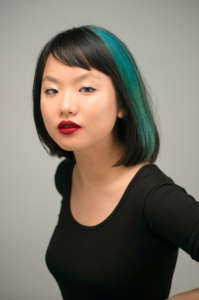
Seonjae Kim
Interview with Seonjae Kim, the Director of Sister Mok-rahn. Seonjae Kim is a director based in New York City, originally from Seoul, South Korea. Riot Antigone, her Riot Grrrl musical adaptation of Sophocles’ tragedy, premiered at La MaMa Experimental Theatre Club in February 2017. Other credits: The Essential Ella Maythorne (Dixon Place), You’re Amazing!!!, That Noise (Williamstown Theatre Festival), A Midsummer Night’s Dream (Rabit Bat Theatricals), Cloud 9, A Perfect Wedding, Kafka on the Shore (Northwestern), Moksori (Chicago Fringe). Kim has worked with renowned directors such as Bill Rauch, Stafford Arima and most recently Pam MacKinnon on the new Broadway musical Amélie. Alumna of Directors’ Lab West, SITI Company, Summer Workshop, Powerhouse Training Program, Williamstown Directing Corps, La MaMa Umbria Directors’ Symposium, Playwrights’ Retreat and Next Generation Residency. 2016 Van Lier Fellowship for Directing from the Asian American Arts Alliance & 2016 Mike Ockrent Fellowship from the Stage Directors and Choreographers Foundation. Upcoming: Associate Director, KPOP (Ars Nova/Ma-Yi/Woodshed Collective).
Chon: Could you talk a little bit about how you chose to direct this play? Why this play?
Seonjae Kim: I had the pleasure of meeting the translator Dayoung through a mutual friend in the winter of 2016. We immediately connected as fellow Korean theater makers in New York City. I then got to direct a scene from Sister Mok-rahn as a presentation for one of her dramaturgy classes. I immediately fell in love with it – for its deeply moving journey, its epic theatricality and beautiful language.
Chon: Could you talk about the challenges in directing a reading of a play with multiple settings and multiple doubles? What were the challenges in rehearsal?
Kim: I feel it was ultimately an impossible task to put up a reading of this play with 8 hours of rehearsal (the festival’s constraints) and I really hope I get a chance someday to direct a full production of this! Honestly getting through all the settings, all the characters, all the subplots were a struggle for time itself. I talked about this a little bit at the post-show discussion but a wonderful challenge was “translating culture” through the acting and direction. As Dayoung mentioned the original play contains many different Korean dialects, it’s almost impossible to find “equivalents” in English, and she did such a great job in her translation to make sure what the dialect might connote – someone’s social class, or what archetype they are, whether it sounds more formal or casual or crass – came through in the English language. So my job was to make sure the actors understood what the language was doing in the original, understand the context of each joke and each phrase and what it means in Korea, then understand what Dayoung’s language is doing, and how our work may close the gap. And this process requires a director to understand not only both languages but both cultures. There are moments in the show where a character’s motivation may not “make sense” to someone who grew up in America, but if you think about it in the Korean cultural context it’s perfectly natural. There is wordplay/puns/poetry that Dayoung and I collaborated on to find English substitutes for that would land best. This is why I think it’s so important in work like this to put the means of production in the hands of the people whose stories are being told, because you have to understand the play through lived experience, and I was grateful to work on it.
Chon: As Korean artist, how do you see the value of this reading (a reading of a Korean play in translation for New York audiences)? How do you think this opportunity benefits the Korean artists and the Korean theatre scene in Korea?
Kim: I think opportunities like this are important because we need to move past the idea that the Western canon is the “universal” one. Even in non-Western countries, that’s a tendency. So I hope Eunsung is proud, and I hope there are more opportunities like this to keep pushing towards a more diverse canon that actually reflects the wide world we live in.
Chon: How do you think this reading benefits the New York theatre scene? How does this benefit Korean, or Asian, artists active in New York?
Kim: As a Korean artist working in New York, I was really grateful to work on something where I felt like my lived experience as a Korean was invaluable to the process of making the piece. Presenting a piece like this exposes New York audiences to something different than what is on major Broadway and off-Broadway theaters, and of course, creates meaty job opportunities for Asian/Korean directors and actors.
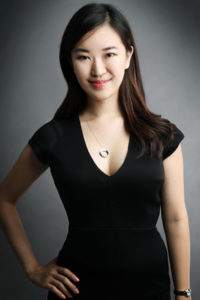
Dayoung Jeong
Interview with Dayoung Jeong, the Translator of Sister Mok-rahn. Dayoung Jeong (first name pronounced like “da” in “ta-da!” and “young”) is a theatre artist, translator, and administrator from South Korea. Her plays include Blur in Grief and Turn Baby, Turn. She has worked with various artistic organizations across different forms, including writing a script for Sejong Soloists, A Sunflower for Vincent (Lotte Concert Hall), and providing interpretation and dramaturgical support for the premiere of The Sleeping Beauty and La Bayadére for the Korean National Ballet. Dayoung received her MFA in Dramaturgy from Columbia University.
Chon: Could you talk a little bit about how you chose to translate this play? Why this play?
Dayoung Jeong: Every time I get this question, I feel like I’m in a confessional. A few years ago, I was interning at Play Company which often produces foreign plays alongside American plays. It’s not that PlayCo necessarily expected me to introduce South Korean plays but I felt like I had to do so since I’m from South Korea. The problem was that I was not very familiar with the Korean theater scene. (Mea culpa.) It’s quite ironic considering that I’ve spent my formative years in Daehakro in Seoul which is not too unlike Times Square–it’s a theater district. But when I was growing up, I always thought the theater was something only for “artsy” people. Even the reason why I came to New York was partly because I desired to study Shakespeare in English, not necessarily to cultivate cultural exchange between South Korea and the United States. So I read Korean blog posts to create a list of plays that I’d like to read. Since very few plays are published in South Korea, I just sent cold-call emails and Facebook messages to playwrights and theater companies to see if I could get their scripts. Among them was Eunsung Kim who graciously sent me his scripts. When I started reading Sister Mok-rahn, I couldn’t put it down. The premise of the play prevented me from taking a break from reading the play. A North Korean refugee in South Korea wanting to go back to North Korea? I had never imagined that any refugee would want to go back to where they managed to escape from. It did not take long for me to empathize with the reason why Jo Mok-rahn wanted to go back to North Korea.
I do not want to give out too much about the play here but the play made me think about how we are treating our new neighbors who just moved around the block, especially those who may seem different from ourselves. Truth be told, I have run into a few “North Korean resettlers” while I was in college in South Korea. In a hushed voice, my acquaintances told me that they were from North Korea. I still blush just by remembering those days but I never made an effort to reach out to them. I was afraid of making an insensitive remark while talking to them. Unfortunately, I did not even get to learn their names. So they are still “they” to me, without names. This binary between us and them is so arbitrary and yet, it still exists just about anywhere in the world. And because of that, I think “we” should think about how better “we” can live in a symbiosis with “them.” As the United States is a country of immigrants and NYC is one of the most multicultural cities in the world, I thought this play could resonate with the audience here, too.
Although I loved the play so much, I couldn’t imagine it in English. There were so many hoops for a translator to jump through. For instance, there’s this madam named Jo Dae-jah who runs a “room-salon,” a high-end brothel. She is a linguistic chameleon, switching the language and accent depending on whom she is speaking to. She speaks in three languages (Korean, English, and Japanese) and various South Korean accents. The effect is that you would never know where she is from unless you read the dramatis personae. How do you translate that for an American audience?
So when I was reporting to my manager at PlayCo, I told her, “I don’t know if any translator would be up for this task.” And two years later, I still couldn’t stop thinking of the play. So I ended up taking up the task that seemed impossible.
Chon: Could you talk about your process translating a play that is so inherently Korean? What were the main challenges?
Jeong: You are absolutely right in that this play is so inherently Korean. That is the reason why I thought it wouldn’t be an easy task for a translator and also why I wanted to translate Sister Mok-rahn. I actually wrote a paper on various issues in translating the play, but to just highlight one, it was finding the right voice for the North Korean characters. One of the things that I appreciate so much about Eunsung’s writing is his ability to capture voices of people from divergent upbringings and cultures. For South Koreans, it is easy to detect whether somebody might be from North Korea or not, based on people’s accent. I’m sure it’s the same the other way around, too. So when the South Korean audience heard Jo Mok-rahn, the titular character, speaking for the first time on stage, they would have been able to figure out that she is North Korean right away. This foreignness in her speech is integral to the play.
So I wanted to capture the effect her accent has on Seoul audience and instill it in my translation so that New York audience might experience something similar. When somebody suggested that I should consider adopting a parallel accent such as Scottish accent, I entertained the idea. But what South Koreans associate with North Korean accent is completely different from what New Yorkers might associate with the Scottish accent. Another option would have been to create a fictional accent or dialect. But North Koreans are not mythical creatures. They are real human beings just like you and me. (It goes without saying that I’m not Tolkien.) So the only choice left for me was to highlight the differences in word choice. During the last seven decades of separation, there has been a language divergence in the Korean peninsula. The standard language in North Korea, Munhwaŏ, has gone through state-driven changes. It has become so dissimilar from the language spoken in South Korea that some of the younger North Korean refugees resettled in South Korea need a translation app to read school textbooks. There are many interesting characteristics but many South Koreans perceive North Korean speech to be more antiquated, formal, and aggressive. These are reflected in Eunsung’s writing. So he has made my job easier.
As for the translation process, I cannot take the credit all by myself. It is true that there were many nights that I spent with the source text and my laptop. I always translated as I was reading the source text and my translation out loud to get the rhythm right. But there were also many days that I spent with actors and Seonjae in the rehearsal room. Hearing the words spoken by the actors was an essential part of the process because I didn’t want the translated text to be a literary text. I cannot thank Seonjae and all the actors enough for the thoughtful questions and comments they offered. So the revision was done both in the rehearsal room and in my dorm room.
Chon: As Korean artist, how do you see the value of this reading (a reading of a Korean play in translation for New York audiences)? How do you think this opportunity benefits the Korean artists and the Korean theatre scene in Korea?
Jeong: It has been three years since I’ve come to New York for my graduate studies and I have not had the luck of seeing any Korean play performed in English. By Korean play, I mean a play written by a Korean playwright that has been translated from Korean to English. The cultural exchange between South Korea and the United States is definitely lopsided. You can find many American plays translated and performed in Seoul. But it is so rare to see a piece from South Korea performed here. I know that the reading won’t even out the asymmetry but I hope this would make New York audience more curious about South Korean theater.
Chon: How do you think this reading benefits the New York theatre scene? How does this benefit Korean, or Asian, artists active in New York?
Jeong: When you live in South Korea (and if you were born and raised there and look like the vast majority of other citizens there), you rarely think about your Asianness. I had not thought of myself as Asian until I came to New York. You could say that moving to New York was a wake-up call for me. I still have much to learn about the theater scene and industry here, but one of the things that I have observed was how difficult things are for Asian actors. There are so many talented Asian and Asian American actors out there but there are not many meaningful roles for them. Perhaps opportunities may have increased in terms of quantity but not in quality. When Asian actors of high profile like Jon Jon Briones audition for “Thai Restaurant Owner” or “Thai Drug Lord,” can you imagine what Asian actors without similar credit audition for? To borrow Viola Davis’ words, “You cannot win an Emmy for roles that are simply not there.” You cannot gain distinction for roles such as Asian IT Guy, Kung Fu Girl, or White Protagonist’s Third Best Friend. After the reading, one of the cast’s friends told me that she was very happy to see the cast member playing a character with a full arc. It broke my heart to hear it, although I knew she only meant well. I too was happy that the reading went well but I can’t help but hear what she said over and over in my head. I would love to see more roles offered to and written for Asian and Asian-American actors. The reading of Sister Mok-rahn was just for one night but the nine cast members showed what Asian actors could do when they are offered complex and nuanced parts to play. I hope that night would be a drop in the lake to create a ripple effect.
On a different note, Sister Mok-rahn is also important in that it shows Asians, especially North Koreans, as complex and real human beings. In general, representation of Asians in this country has so many issues. But it’s all the more serious for that of North Koreans. North Korea is not far from the spotlight but the focus is mostly on the nuclear weapon and the Kim family. North Koreans are often portrayed as villains or victims, cut-out cartoon characters. Simple and flat. But the characters you see in Sister Mok-rahn are perfectly imperfect flesh and blood. Even South Korean audience does not get to see such characters often, let alone American audience.
This post was written by the author in their personal capacity.The opinions expressed in this article are the author’s own and do not reflect the view of The Theatre Times, their staff or collaborators.
This post was written by Walter Byongsok Chon.
The views expressed here belong to the author and do not necessarily reflect our views and opinions.

